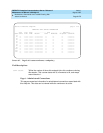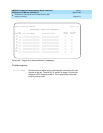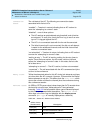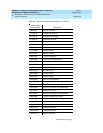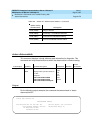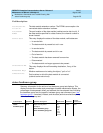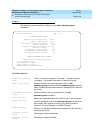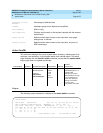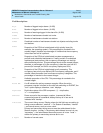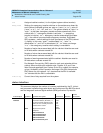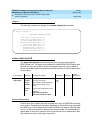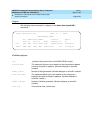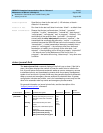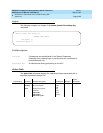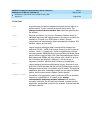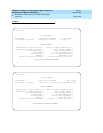
DEFINITY Enterprise Communications Server Release 6
Maintenance for R6vs/si
555-230-127
Issue 1
August 1997
Maintenance Commands and Trouble-Clearing Aids
Page 8-278status health
8
Field descriptions
Major
Number of logged major alarms. (0–200)
Minor
Number of logged minor alarms. (0–200)
Warning
Number of warnings logged in the alarm file. (0–200)
Trunks
Number of maintenance busied out trunks.
Stations
Number of maintenance busied out stations.
Others
Combined number of maintenance busied out objects excluding trunks
and stations.
Static
Proportion of the CPU that is dedicated to high priority items (for
example, the operating system). This percentage is rounded to the
nearest integer, therefore a percentage of 0 means that the occupancy
is less than one half of a percent.
SM
Proportion of the CPU that is dedicated to system management or
periodic and scheduled maintenance. If many periodic or scheduled
maintenance tests perform, this occupancy percentage can be high
without affecting service. This percentage rounds to the nearest integer;
therefore, a percentage of 0=the occupancy is less than one half of a
percent (for example, an 89.6% occupancy displays as 90%).
CP
Proportion of the CPU that is dedicated to call processing. This
occupancy has priority over SM and IDLE occupancy categories, and if
needed, takes processor time from these occupancy categories. This
percentage is rounded to the nearest integer.
Idle
Available proportion of the CPU. This percentage is rounded to the
nearest integer.
Active SPE
A or B indicate the active processor complex. When the active
processor complex is locked on-line with lock switching on DUPINT, the
“lock” option displays; otherwise, “auto” displays.
Duplicated?
Duplication status of the SPE component. “y” = duplication;
“n” = no duplication.
SPE Power
Power source for the processor complex. (commercial) When
commercial power is unavailable, battery backup is in use and is
indicated with “backup”.
Time Source
The current timing source. Display values for this field vary according to
timing sources selected. “external” = For Stratum-3 hardware, “internal”
= an internal source, such as a tone clock.
Primary and secondary timing sources must be administered for the
Stratum-4 option. “primary”= the primary administered source is in use,
“secondary” = the administered secondary source is in use. “local” =
neither the primary or secondary sources are in use.
# Logins
Number of current users.



